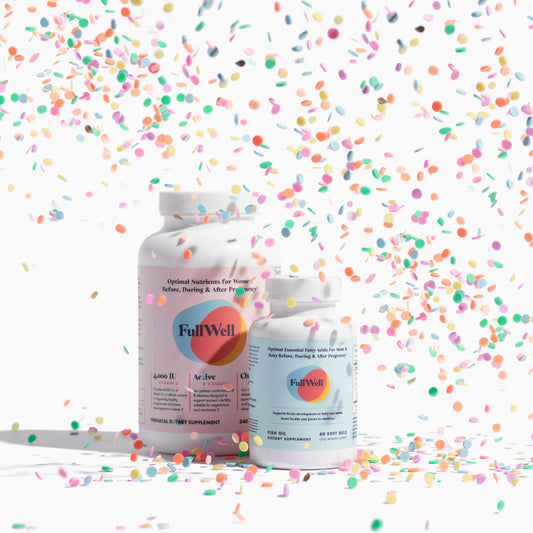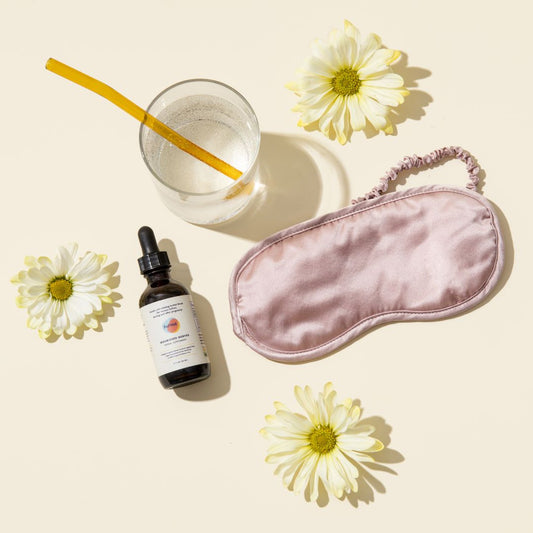Theoretically, we all have an idea of the list of things to do before baby arrives.
In preconception, we nurture our fertility, nourish our bodies, prepare to be pregnant, and grow a new life. Sound sleep, managed stress, healthy movement, quality nutrition, and a solid prenatal vitamin are all things we talk about all the time.
During pregnancy, we try to stay on top of all that excellent self-care work as baby develops. Many have the benefit of medical professionals monitoring the additional changes and advising on how to navigate in the healthiest way for both mom and baby.
Then, we give birth, and everything becomes about this utter miracle we’ve made (!). But as the highly emotional post-delivery shimmer leaves our vision and we slowly ease into our new lives (with an actual new life!), our self-care and recovery tend to take a backseat.
Sound familiar?
[In my mind, I just saw all of my experienced mamas' hands shoot up in the air lightning fast.]
Right. That’s what I thought.
I want to take a few moments - both for my first-timers and for those who have had kids but are still in the process of growing their families - to highlight a few ways to prepare for postpartum to not only make it easier but to have a more enjoyable, healthful experience all around.
You’re already thinking of the big picture, but I challenge you to think even BIGGER, beyond giving birth.
My amazing team at FullWell has helped me compile the top lessons we’ve learned (or learned through loved ones) for recovering after delivery. This is an excellent opportunity to throw a nesting party with your loved ones. The basic idea is that friends and family come over to help you prepare for the postpartum period in whatever way you like. Read on for linked resources to help you!
I’ll break it down into three goals: nourishment, physical healing, and mental/emotional well-being.
NOURISHMENT
There are a few key things you can do before giving birth to set up a simple system for ensuring both you and your newborn (and the rest of your family) are being optimally nourished once you deliver.
FEEDING BABY
- If you can, establish a relationship with a lactation counselor before you give birth, ideally, an International Board Certified Lactation Consultant (IBCLC). Nest Collaborative offers virtual breastfeeding consultations - perfect for these new times we’re living in - and The Lactation Network can help you determine if your state or insurance plan covers this service (and how much it will cost you otherwise).
- If a lactation counselor is not an option, there are several excellent online feeding resources you can turn to, like Kelly Mom. Other breastfeeding moms are also great resources.
- That said, try watching a few feeding basics videos before giving birth if it’s your first time! The more you know, the more you know, and observing others can help you figure out what could work for you and what might not.
- Stay well hydrated to help with milk production (if breastfeeding/pumping) and to help relieve constipation, which is incredibly common after giving birth. A big stainless steel water bottle with a flip straw has been a non-negotiable for new mamas on our team. You’ll also want to get plenty of electrolytes and supplement for any specific gaps you’ve worked to identify with your doctor. Some of our favorite electrolyte-rich hydrators are coconut water or warm bone broth with a sprinkle of seaweed flakes.
- Have nipple care on hand, especially in those early days when you’re still adjusting. Our team loves the Silverette Nursing Cups, and I recommend taking a stab at making your own nipple cream using oat straw, one of my favorite herbs that is deeply nourishing and beneficial for soothing inflamed skin. Oat straw is so effective and gentle that you can even use that same cream on baby for diaper rash.
- Perhaps one of the most essential pieces of advice we all agree on is that you have to give yourself some grace. There is a ton of confusing energy around breastfeeding and uncalled-for judgments for those who can’t or choose not to for whatever reason. The reality of the situation today is that we all know breastfeeding is excellent, but it’s not always the path for everyone. If that’s you, stay in close contact with your doctor to ensure baby is getting everything they need, and don’t give it a second thought. You are doing the best you can. Especially if you’re listening to your body and utilizing the support of modern science, that is good enough.
FEEDING MAMA (AND FAMILY)
Your nutrient intake is just as important during this phase as during preconception and pregnancy. The only significant difference is that you are no longer actively building another human being! Instead, you’re eating to support your recovery, replenish nutrient stores, and nourish baby if you’re breastfeeding. Your personal energy needs could go up by as much as 500 kcal per day if you exclusively breastfeed. It can be tempting to want to lose weight after giving birth. However, it’s important to note that eating enough food is key to maintaining your milk supply. Nutrient-dense snacks and meals can help replenish your nutrients while providing nutritious, ample breast milk for your growing baby.
In my private practice, I always advise new mothers to remain on their prenatal vitamins for at least six months postpartum or longer if breastfeeding. Not only do you and baby need those micronutrients, but continuing to take your prenatal during this time helps you stick to a routine when you’re busy worrying about a thousand other things. After all, who has time to think about each of the following individual nutrients with a newborn?!:
- Vitamin A is crucial for your infant’s growth, reinforcement of their immune system, and the development of their brain and vision
- B vitamins play a vital role in your baby’s cognitive development
- If breastfeeding, this will be the first time you are asked to think about your vitamin C intake on a larger scale than what is in your prenatal. Vitamin C is a powerful antioxidant, helps absorb iron, and famously supports immune health
- Your choline needs increased by as much as 50% while pregnant, but I’ve got news for you: they're still going up. The recommended dose postpartum is around 550 mg (as opposed to the 450 mg suggested during pregnancy). And newer research suggests that those numbers may need to be nearly doubled for breastfeeding mothers!
- Vitamin D is essential in supporting immune function, cell division, and bone health; even under regular circumstances (e.g., non-pregnant or breastfeeding), it is easy to be deficient. Supplementing to reach ~6400 IU has been shown in a well-designed randomized clinical control trial to be the level at which enough vitamin D will pass through the milk to baby, which is a study to discuss with your pediatrician when deciding whether or not baby needs a vitamin D supplement.
- Vitamin E is necessary for supporting the body’s free radical defenses, which is essential for your baby after birth (after all, leaving the womb is a rough process for both of you!)
- Once baby is born, iodine will become vital to brain development, thyroid health, baby’s immune system, and overall growth
- If you’ve been on top of your iron consumption preconception and during pregnancy, your body has probably done a great job building its iron stores. However, because iron is so crucial for red blood cells, muscles, and tissues, depending on your delivery and postpartum experience, you might lose those stores faster than you think. Keep your focus on heme iron-rich foods like grass-fed meats, free-range poultry, and wild-caught seafood. Beans, legumes, and dark leafy greens are great plant-based options when paired with foods that contain vitamin C, and eating them together will help your body absorb that non-heme iron more efficiently
- Keep taking omega fatty acids with at least 400mg of DHA and some EPA, but remember that food is a fantastic (and often incredibly delicious and satisfying) source you can rely upon for your omega 3s. The type of fat you eat directly impacts your milk's fatty acid profiles. This rings true for omega-3s, omega-6, trans fats, saturated fats, and monounsaturated fats. In addition to diet, milk fatty acids can be drawn from maternal stores or synthesized in your breasts, and with more than 150 different fatty acids at play, you can bet they are flowing into your milk from many different pathways. The most important thing to remember is that healthy fats = unprocessed fats. I want you to look to extra virgin oils (low heat, no solvents, minimal treatment) like olive oil, avocado oil, macadamia nut oil, and coconut oil. Animal fats like lard and tallow are acceptable, provided they come from healthy animals, and you know I love a full-fat dairy product, so don’t shy away from butter, ghee, cream, and any fat that naturally occurs in food (e.g., seafood, eggs, etc.)
Think about how you can make quality nutrition easier ahead of time. Ask a friend or family member to set up a meal train for the days/weeks directly following your delivery. Having loved ones contribute healthy, ready-to-eat meals and snacks to your recovery process will keep you (and your family) fed and nourished through some challenging times and potentially save you a lot of extra time and energy when it already feels like you’re running on empty.
This is also a great way to add low-cost/light-lift gift options to your baby registry for those who need them. Signing on to provide a home-cooked meal or deliver a few necessary groceries is a much more viable option for many folks than that $500 stroller attachment!
Postpartum doulas are also great if that’s an option for you. Unlike the doula who supported you through pregnancy, a postpartum doula will focus specifically on you and your nutrition and recovery.
- Another option to think about is including a meal prep/delivery service subscription to your registry or just investing in one yourself if you think it’s something that will be of value to you. In the northeast, we love services like Snap Kitchen that source fresh produce, cook delicious small batched recipes, and flash freeze and deliver them regularly so you can heat and eat easily (they even offer family-style options). Other services like Nouri Mama are specifically designed and tailored to women at each stage of pregnancy and postpartum.
- Finally, and perhaps most importantly, understand that there is a big difference between staying well-informed about your nutrition and trying to be perfect. The idea that you must eat perfectly assumes that eating perfectly is possible. I’ve got news for you: it’s not (and that’s coming from a registered dietitian). There is no perfect way to eat at any phase of life. We educate ourselves, listen to our bodies, and do our best.
Here’s a rough idea of one version of a potentially optimized postpartum meal makeup:
PHYSICAL HEALING
Before your due date, consider compiling a “birth recovery kit.”
A few companies sell these, like Bodily (they have them for both C-sections and vaginal delivery). You can either invest in a premade kit or DIY your own! If you’re thinking far enough ahead to take the DIY route, members of our team recommend including the following:
- Reusable high-waisted postpartum underwear for lochia (if vaginal delivery) and abdominal recovery. Thinx (the period underwear) and Nyssa have great postpartum options that come in different sizes
- A belly band for abdominal support. This will prove to be helpful no matter how you end up delivering
- Reusable maxi pads to make padsicles. Yes, you read that correctly, padsicles. Funny name, seriously critical item. While mass-produced padsicles aren’t totally mainstream, Nyssa does make a gel version that is compatible with their underwear. However, making your own is easy and probably way more cost-effective than buying them. A padsicle is precisely what it sounds like: a frozen maxi pad that you will want on hand after vaginal delivery to help soothe swelling and pain around the perineum and vulva and encourage healing. Some choose to freeze them with witch hazel, and you know us: the FullWell team is pro herbs whenever the research supports it. One of our new mamas steeped an herbal tea with comfrey and plantain leaves and sprayed a light layer on her pads before freezing them in silicone bags. She recommends wearing them for an hour or so 1-2 times per day for a couple of weeks and says you can even use this tea as a perineum spray in a peri wash bottle or regular spray bottle after using the bathroom. Alternatively, cooling gel pads can also fit inside of underwear and can be used on c-section incisions
- A robe with pockets and other comfortable, nursing-friendly bras, pajamas, and loungewear
- A small pharmacy of herbal allies: Postpartum teas and infusions. You can search for brands with ready-made mixes, but I suggest trying your hand at creating your own based on what you feel you need after reading up on it. Mountain Rose Herbs and Frontier Co-Op is an excellent source of organic, loose-bulk herbs
- FullWell’s Nourished Nerves tincture is clutch for support in balancing stress and promoting quality sleep (trust me - I formulated this one because I know how important it is to take that help wherever you can get it!)
- Bone broth from a company like Fond for fast, easy nourishment. You can also make large batches of your own to your tastes in a crock pot and freeze half in jars and half in ice cube trays for easy additions to meals. The collagen in that bone broth is so important for recovery! A quick and nourishing meal could be as easy as a super simple egg drop soup with scrambled eggs, bone broth, chopped green onions, and either seaweed flakes or miso for a probiotic boost. Freeze hearty soups and stews, or be your own preemptive meal service, as discussed earlier. There’s honestly no such thing as being over-prepared here. A good chili with ground beef and chicken/beef liver for some extra iron is a FullWell staff fav
- Cozy socks with grips on the bottom! Some swear by compression socks, which I can also get behind
MENTAL/EMOTIONAL WELLBEING
It’s easy to lose yourself in the shuffle around this time. Ask any woman who has given birth: there is nothing like creating and carrying a baby and bringing them into the world. You may experience little to no mental or emotional extremes after giving birth. It’s also possible that you will be the most emotional you’ve ever been, and you could swing back and forth daily, filled with utter joy one moment, and spiraling the next. It’s possible you could go through something somewhere in between! Every woman is different.
- Postpartum depression is natural, normal, and should be identified and discussed early on without judgment or stigma. If you are familiar with FullWell, you know that we have a GiveBack Program that allows a percentage of our sales to support organizations that align with our values. One of those organizations is Postpartum Support International. Not only do they host a 24-hour hotline, but they also provide resources for finding postpartum mental healthcare in your area, no matter where you live. What’s more is that they also offer support for new fathers (they’re adjusting, too).
- In fact, it’s essential to take stock (or ask a third party for help taking stock) of the entire family. According to PSI, 1 in 7 new mamas and 1 in 10 fathers suffer from postpartum depression, and its effects can also extend to older siblings.
- All-encompassing medical services such as Parsley Health and Ask Tia are available to help you recover physically and take care of mental and emotional recovery.
“Consider this an article to get you thinking about your personal needs and what could work for you. Discuss your ideas, questions, and concerns with your healthcare provider, and start making moves from there. Remember: start where you are, use what you have, and do what you can.”


